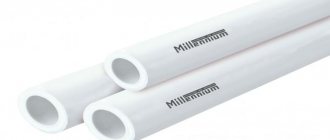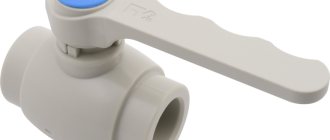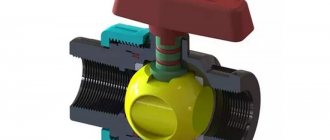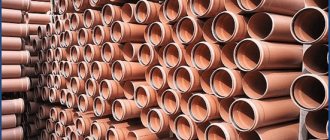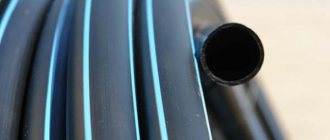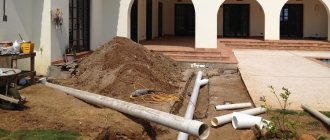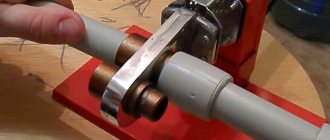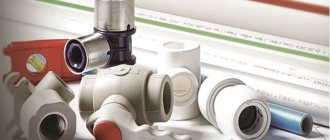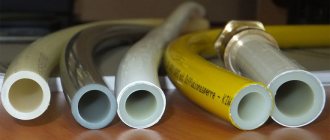Collector distribution of water supply pipes in an apartment
Collector distribution of water supply pipes in an apartment differs from the standard system by the installation of a T-shaped distributor. The wiring diagram has many advantages, one of the important ones is adjusting the pressure so that it is the same along the entire length of the pipeline, making the process of repairing outdated sections easier.
Collector device - what is it? The collector device is a plumbing part that helps mix the water of two branches; from the collector, water flows to different points in the system. From the device, the water is divided into streams that have the same pressure. Thus, the manifold is considered to be a fluid distributing mechanism.
It is installed on the central riser pipe. Collector wiring involves installing a collector. The design of the collector is simple; you can install it yourself.
Installation according to the collector circuit
Principle of organization of collector systems
Do-it-yourself collector distribution of water supply in an apartment is carried out according to the following principle - the central branch does not have branches, but is connected to a collector, to which, in turn, the supply lines for each device are connected.
When installing heating systems, collectors are installed in special cabinets (when implementing a scheme for houses with several floors, collectors are installed on each floor). Cold and hot water supply systems are installed in the same way. In apartments, water supply collectors are conveniently installed behind the flush cistern in the toilet. The collector principle of supplying water or coolant is also called radial, and it has its own characteristics for water supply and heating systems. These nuances deserve close attention.
Manifold cabinet design diagram
Installation of collector water supply
The junction of the collector with the central pipe is equipped with a ball valve to allow a general shutdown of the water supply. The valve is complemented by a pre-filter (coarse) filter, which traps large insoluble inclusions that can damage other equipment.
If you follow the flow of water, after the coarse filter there should be a liquid flow meter (meter), and after it there should be another filter that removes smaller inclusions (compared to the first).
The next element of a well-designed water supply pipe distribution system in an apartment is a check valve, which prevents the reverse flow of liquid from the collector into the central pipe when the water supply pressure decreases.
Only after the equipment listed above is the connection to the collector made. Each collector outlet is equipped with its own tap to turn off the branch’s water supply.
The photo shows an example of water distribution in a collector-type apartment
When choosing and installing a collector, one of the determining factors is the number of water consumption points. It must correspond to the number of outlets, and to be able to connect additional plumbing equipment in the future, you should choose collectors with a large number of outlets. Those of them that are not used in the system until a certain point are provided with stubs.
If the central branches of both cold and hot water supply enter a house or apartment, the installation of water supply distribution in a collector-type apartment is identical in both cases. If there is only a central cold water supply, one of the outlets of the cold water collector directs the liquid to the water heater, from where the heated water flows into a separate collector for hot water distribution.
A radial water supply project must take into account not only the number of water consumption points, but also the distance from the collector to each of them. The optimal point for installing the collector is the location closest to the maximum number of consumption points, so that the distances are approximately the same and the outlets do not require too many pipes.
A description of the types of pre-filters is here.
If you have to choose a water heater, we recommend reading this material. In it you will find a comparative analysis of storage and instantaneous water heaters.
Collector heating
The collector heating circuit is implemented as follows:
- The boiler supply fitting is connected to the pressure pipeline, which supplies the coolant to collector No. 1.
- The outlets of the first collector are connected to the upper fittings of the radiators installed in the house.
- A second collector is mounted next to collector No. 1, the taps of which are connected to the lower radiator connectors.
- Manifold No. 2 is connected to the injection pump, and it, in turn, is connected to the receiving fitting of the boiler.
- At the highest point of the circuit, an expander is cut into it, corresponding to the heating circuit (open or closed).
The diagram shows the heating manifold wiring
If there is a central water supply and heating, the collector wiring diagram for heating devices is implemented in a similar way, with the exception of the absence of a boiler, expander and pump.
For the system to operate efficiently, it is important to choose the correct location for installing the collector. It is optimal to place it in the geometric center of the house; the distances from it to all radiators, which are usually located under the windows, will be approximately the same
What is a collector?
When installing a water supply system from scratch or replacing an old one, you need to think about the location of all consumers: toilet, washbasin, washing machine.
In a typical apartment, the number of plumbing fixtures varies from four to ten. Experienced plumbers recommend their customers to install a water collector.
A water collector is a kind of distributor, which is an important plumbing element of a cold and hot water supply and heating system. It is installed on the central riser and hidden in the plumbing closet. Access to the distribution comb should not be blocked by furniture or sewn tightly into the wall. However, professional repairmen will give the engineering unit an aesthetic appearance.
Installation stages
All work to create the wiring of the water supply system in the apartment has the following sequence:
- First of all, emergency valves must be installed on the riser.
- Next, meters are installed, as well as water filters.
- The next step is to install the manifold, after which ball valves are installed at the outlets.
- Now all plumbing fixtures are connected.
- The last stage is to check the entire system for functionality.
If the water supply distribution is to be created in a new building or in an ordinary apartment where the entire system is being completely replaced, then it will not be difficult to do everything yourself.
Please note: if you are installing pipes in a fairly old building, first of all you need to check the condition of the main riser there, since it may be necessary to initially replace it due to wear.
Installation features
Sewerage construction is carried out on the basis of design data. Preliminary calculations and creation of an assembly diagram are carried out in accordance with SNiP and SanPiN standards, ensuring full compliance with all requirements.
The pipeline is laid at a depth exceeding the winter freezing level of the soil. Procedure:
- excavation. They dig a trench for the pipeline. Immediately make nests for inspection wells;
- a sand cushion is poured onto the bottom of all recesses to level and give the desired slope;
- by laying pipes with a certain slope towards the receiving tank (usually for gravity systems 2 cm per meter);
- if plastic containers for wells are used, a concrete slab - an anchor - is first laid at the bottom. It prevents the reservoir from being squeezed out by groundwater;
- All connections are carefully sealed. Check the system for leaks. After this, the pipes are insulated and covered with soil.
When constructing pressure sets, the SPS is first assembled, after which the remaining trenches are laid according to the described scheme. For maintenance and repair of pumps, it is necessary to ensure access to the station at any time of the year.
Advantages and disadvantages
First we need to talk about the disadvantages of the collector system. Why is not all apartments equipped with a collector distribution of water pipes? The answer here is quite simple: you have to spend a lot of money to create the system. There is much more work to be done than when creating a tee system.
So, to power a washbasin and toilet, for example, you will need five meters of pipes for tee wiring, and nine meters of pipes for collector wiring. In addition, special shut-off valves for manifold wiring are expensive.
If renovations in an apartment do not involve a global replacement of water pipes, then you will feel the difference between one pipe on the wall and six pipes.
Therefore, most often a collector system is created when the entire water supply system is changed and it is possible to hide the pipes in special boxes or in the wall. Undoubtedly, collector distribution of water pipes has advantages.
In a small apartment, such a feature may not mean anything to the owner. However, when it comes to hotels and large establishments, such a system is a real godsend.
And what then should you do if, for example, in a hotel, a pipe bursts in one of the rooms? Cutting off the water supply to an entire hotel is suicide, especially if the establishment has a high star rating. The hotel's rating will drop the moment the water is turned off. But if you close the water supply to one room from the collector, that’s a different matter.
The collector system is particularly beneficial for heating systems. For example, you can reduce the temperature on one of the radiators using a throttle valve. In the water supply system, you can limit the use of water, for example, on the sink, where children often like to play. What if they leave the tap open and walk away?
No, the apartment will not flood, but in a few hours, until the adults discover the open tap, about seven to eight cubic meters of water can flow on the meter. If the tap is opened halfway, the numbers on the meter will be half as large.
One more situation can be imagined. With tee wiring, a shower and toilet are connected. You take a shower, the hot water is diluted by the pressure of cold water. Then at this time your wife went to the toilet and flushed the toilet with water from the tank.
What will be next? The cold water pressure will immediately be distributed equally between the shower and toilet. The fact that water will fill into the toilet slowly is not a problem. But getting caught in boiling water from the shower is not very pleasant. In the case of collector wiring, the water supply to the shower and toilet will be the same in any situation.
Rules for installing heating systems
In heating systems, two collectors are used - supply and return. If the system is supposed to be balanced manually, control valves and balancing flow meters are connected to the supply manifold pipes, and shut-off valves are installed on the return side.
Theoretically, instead of control valves, you can use cheaper shut-off valves - with its help you can also change the amount of fluid flow. But in this case, it will quickly fail, since it is not designed for this mode of operation.
Collector heating system
If there is a thermostat in the heating system, instead of manual taps, fittings with servo drives are installed on the supply manifold. In this case, the coolant flow through each radiator will be adjusted automatically.
The supply manifold should be located higher than the return manifold. The pipes themselves can be laid any way you like.
If in a traditional radiator connection scheme the supply line must be higher than the return line, then in the collector line their location does not matter at all. Therefore, pipes are most often laid inside the floor.
Distribution manifold
Now let's find out why distribution manifolds are needed for water supply. We already know that they allow you to power several water points independently of each other; but how is this useful?
Advantages
Unlike a sequential (tee) system, the scheme of a collector water supply system allows you to avoid a drop in pressure when water flows through an arbitrary device. Simply put, when you turn on the tap in the kitchen, you don’t hear the pained and bitter cries of a family member taking a shower from the bathroom.
Collector water supply scheme for a private house: each device is connected to the collector with its own connection
In addition, a manifold-fed water supply with taps in the manifold cabinet allows you to turn off any plumbing fixture from one point. This is very convenient in public buildings, shopping centers or mini-hotels: if there is a water leak, you can turn it off without even having access to the relevant premises.
Flaws
Alas, the collector water supply scheme has several unpleasant features:
- Material consumption. Obviously, the total length of the water supply connections will be several times greater than with a tee circuit;
- If you install a collector for the water supply, the lines have to be laid hidden (in grooves or screed). Agree that a dozen parallel pipes on the walls of the bathroom and kitchen are a bit of an excess;
Cold water and hot water supply lines are laid in screeds, grooves or routed throughout the basement
Concealed installation entails the difficulty of localizing and eliminating leaks. If the neighbors below begin to get their ceiling wet, it will cost you a lot of work to find a fistula in the water pipe laid in the screed;
Openly laid water supply lines can be changed without damaging the finish
Installation
How to install a collector for the water supply of an apartment with your own hands and route the pipes to the faucets, toilet cistern and other appliances?
A cut-off ball valve, a coarse filter and a water meter are sequentially mounted in the riser (see Water supply meter: everything you need to know about these devices). If necessary, they can be supplemented with pressure reducers and pressure gauges;
In this water supply system, the installation of the collector was accompanied by the installation of a pressure gauge
Collector water supply system: size of taps into the riser - DN 20
Distribution manifolds for water supply (cold and hot) are attached to permanent structures with clamps;
Assembling the water supply manifold: ball valves need to be installed on the terminals
Distribution manifold - Valtec water supply manifold is equipped with ball valves at all outlets
- The tap threads or manifold outlets are equipped with adapter fittings to which connections to plumbing fixtures are connected;
- When installed hidden, the connections are thermally insulated. Insulation will avoid the appearance of cracks in the screed or sealing of grooves due to cyclic heating by hot water pipes, and will also reduce heat loss.
Please note: all connections are thermally insulated
What pipes should be used for water distribution?
As we have already mentioned, the water supply scheme we are interested in—collector—implies hidden installation of connections. However, for reasons of fault tolerance, all serviced fitting connections must be installed openly.
The list includes:
- Cross-linked and heat-resistant polyethylene;
- Metal-plastic;
The collector water supply system in the apartment is mounted with metal-plastic on press fittings
Corrugated stainless steel pipe (see Corrugation for water supply pipes: one step away from perfection).
Corrugated stainless steel for water supply
The metal-plastic pipe in the photo collapsed due to water hammer
The only exception to the general rule is polypropylene. Polypropylene pipes are supplied in straight sections, but their connections are maintenance-free and are as strong as a solid section of water supply, so they can be safely laid in screeds or grooves.
Polypropylene manifolds for water supply can be connected directly to polypropylene connections, without additional fittings
Collector design and principle of operation
The direct function of a collector in a water supply system is to distribute one water flow into several flows of equal pressure.
Combs with two, three and four outlets are available. If more branches are needed, the distributors are connected to each other. In this way, a water supply collector is assembled for the required number of outlets.
The collector is connected directly to the riser. On two opposite sides of the device there is a threaded connection (internal thread on one side, external thread on the other) for connecting to the main line and connecting the combs to each other.
A plug or an additional plumbing device, for example, a membrane water hammer absorber, is installed at the free end of the collector.
The diameter of the inlet hole is 20-40% larger than the outlet hole. For example, on a standard manifold for installing water supply in an apartment, the diameter of the inlet hole is 3/4 inch, the outlet hole is 1/2 inch.
1. Manifold with valves. 2. Manifold with ball valves.
Both ball valves and valves can be installed at the outlet openings, allowing not only to open and close the water flow, but also to regulate the power of the flow in this area.
Types of water supply pipes
The main types of pipes used in organizing water supply:
- Copper pipes connected using special solders. The lines are resistant to corrosion and can withstand heating up to 250°C. Pipes are elastic, which allows you to create pipelines of complex configurations. The disadvantage of the material is the formation of a galvanic couple upon contact with aluminum or steel elements. When used in multi-storey buildings, one should take into account the high current conductivity; if the neighbors’ equipment breaks down, the pipeline becomes energized.
- Metal-plastic pipes consisting of several layers of plastic with an aluminum gasket. The products are highly elastic; threaded bushings or crimp elements are used for connection. The products are not used for hidden installations, since the rubber seals at the joints lose their elasticity and allow water to pass through. The advantage is the absence of corrosion; the smooth internal surface prevents the formation of deposits.
- Products made of polybutylene that can withstand heating up to 90°C. The elements are connected using soldering technology, the seam is characterized by increased strength. Due to the high cost, polybutylene products are not widely used; the pipes are used in the construction of heated floors.
- Polyethylene reinforced pipes designed for pressure up to 3.5 atm. Use in water supply networks is not recommended, since the material is not highly durable. The parts are used for distributing water in personal plots or in domestic buildings; the material allows the liquid to freeze. When connecting, it is necessary to install a reducer that reduces the pressure of the water flow to a safe level.
- The lines are made of polyvinyl chloride, which is characterized by high chemical resistance and allows operation at temperatures up to 80°C. The disadvantage of the material is its low resistance to ultraviolet radiation. Soldering or glue is used to connect pipe fragments, but the strength of the joint does not allow water to be supplied under pressure above 3.5 atm. Pipes are used for water supply to technological premises or when organizing irrigation systems; a reducer is provided in the main line to reduce pressure.
- Pipes made of polyisopropylene, allowing elements to be connected by soldering. The material is low cost and allows pressure up to 12 atm. and temperature up to 130°C. The surface of the pipes is rough, but plaque does not form in the inside of the lines. The products are used for organizing risers and for distributing water inside residential or office premises.
When selecting pipes, you should take into account the cross-section of the internal channel, on which the throughput depends. To determine the parameter, it is necessary to find out the required pressure in the lines; the coefficient of pressure drop inside the pipe and at the joints is taken into account. When planning the laying scheme, straight sections should be used, but excessive lengthening and cluttering the branch with reinforcement lead to a drop in pressure.
Rules for installing water supply systems
For the water supply you will also need two collectors: one for hot water, the second for cold water.
In this case, there is no need to install control valves - a shut-off valve is sufficient. Typically, taps on manifolds for cold water are equipped with blue handles, and for hot water - red.
The water supply manifold should be installed in a dry place: in a closet, for example, or in a corridor.
The ideal option is installation in a cabinet (the collector is equipped with special fasteners), but if you are not going to spend money on buying it yet, you can simply place the part in some niche.
As already mentioned, the absence of connections on the pipes between the devices and the collector allows them to be laid in a hidden manner. It should be taken into account that gating of load-bearing walls is not allowed. When laying hidden, all pipes, even with cold water, must be covered with a sleeve made of foamed polyethylene. This material will provide the gap between the pipe walls and the solution necessary to compensate for free thermal expansion.
Bathroom renovations involve not only replacing plumbing fixtures, but also installing new pipes. Laying out pipes in the bathroom with your own hands - dismantling used pipes and methods for installing new equipment, read about this in the next topic.
Is it worth it to drain the floor in a shower and what are the advantages and disadvantages of a simplified drain system? Read this link.
Tools, materials, dismantling old
Special tools for assembling residential pipelines are described above. To purchase materials, of course, you will need to calculate the footage, nomenclature and quantity locally. Dismantling old pipes is done in the usual ways. It is better to do this after installing and registering the water meter, so as not to turn off water to the floors for a long time.
We will give only one piece of advice: do not use valves with a lever. It is made of silumin or plastic and tends to break off at the most inopportune moment, just when you urgently need to close it. Take ball valves with a butterfly handle. The round, grooved handles also do not break, but wet or sweaty hands slip on them.
Intra-house system
Let's start with that part of the wastewater disposal system that is located within the walls of the house.
Comb
What is a sewer comb?
This is what is called internal wiring. It got its name from the shape characteristic of apartments with adjacent bathrooms and kitchens: three outlets on a horizontal pipe (for a kitchen sink, washbasin and bathtub) actually somewhat resemble a comb.
In the last century, until about the 80s, the traditional material for the comb was cast iron pipes and cast iron fittings. The socket joints were hammered with heel (organic fiber with antiseptic impregnation) and covered with cement mortar. Less commonly, pouring molten sulfur was used to seal joints.
Please note: when dismantling such connections with your own hands, you have to warm them up with a hairdryer, torch or blowtorch. Work is performed only in a gas mask or respirator. The instructions are due to the fact that the fumes are extremely caustic: they can cause respiratory paralysis.
In houses built at the end of the last century, solid polyvinyl chloride combs predominate. In current new buildings, sewage systems inside apartments are installed mainly from the same polyvinyl chloride pipes; however, now it has become prefabricated and is performed on socket joints with rubber ring seals. Along with PVC, polypropylene and, somewhat less frequently, polyethylene are used.
Modern plastic comb.
Risers
The combs, located one above the other, are connected by a sewer riser. The evolution of the materials used was somewhat shorter than in the previous case: builders switched from cast iron risers straight to prefabricated plastic ones.
The riser is equipped with revisions - hatches for clearing sewer blockages.
Prefabricated riser with inspection for clearing blockages.
The location of revisions is standardized; they must be present:
- On the first floor of the building;
- Upstairs;
- If the building has more than five storeys, every three floors.
The risers are open at the top; This ensures ventilation of the sewer. It is permissible to combine several risers with a common fan (ventilation) outlet.
Lezhnevka
A sewer drain is a horizontal pipe that connects several risers and turns into an outlet to a well. Its installation is carried out with a constant slope along its entire length in the direction of movement of the drains. Counter-slopes are unacceptable: they will become places of constant blockages.
The amount of slope depends on the diameter of the pipe:
| Diameter | Slope, centimeters per linear meter |
| 50 mm | 3,5 |
| 100 mm | 2 |
| 150 mm | 1 |
| 200 mm | 0,8 |
Like the riser, the bed of an apartment building periodically needs to be cleaned.
Revisions or, more conveniently, oblique tees with bends oriented against the flow of drains are installed:
- On turns (if it is not possible to clean the bend through another inspection or tee);
- With a bed diameter of 100-150 mm - every 15 meters;
- With a diameter of 200 mm - every 20 meters.
Inspection of the straight section of the bed.
Outlet to the well
They end up with the bed. The outlet is placed in the ground below the freezing level. Its beginning must be equipped with a tee or revision for cleaning.
Tee before release.
The maximum length of the outlet from the revision to the axis of the well is limited by its diameter:
| Diameter | Maximum length |
| 50 mm | 8 m |
| 100 mm | 12 m |
| 150 mm or more | 15 m |
As a rule, a cast iron pipe is used for laying in the ground. Its price is noticeably higher than that of any type of plastic; but the ring rigidity is much higher: subsidence of the soil under the weight of the car will not cause damage to it.
Products on the market
Depending on the material, the cost of products ranges from 400 to 2500 rubles. Collector groups for 200-300 outputs can cost 10,000-40,000 rubles.
There are models from different manufacturers on the market, the popular ones include:
- Watts;
- Uponor;
- Giacomini;
- APC;
- Luxor;
- Fado;
- Caleffi;
- Valtec;
- Bianchi.
The stores offer not only combs, but also accessories. Products without taps are economical. They are used to install individual wiring and make it possible to select suitable parts. Purchasing a product with shut-off valves will make the installation process easier. When assembling the units, the need to install valves disappears.
To adapt the device to the home system, components are purchased. These include valves, valves, and pump groups. Mechanical drives, plugs and pipes are required.
Manifold cabinets are used for wall mounting and maintaining an aesthetic appearance.
Manufacturing methods
Before you start making a homemade collector, you need to select the material and prepare the necessary equipment. For example, to make a steel model you will need a welding machine. But don’t rush to choose polypropylene. In order to connect polypropylene parts, you will need a special device that is used to weld such pipes. Sometimes it is easier to get an ordinary welding machine than for plastic.
Calculation and distribution of contours
From the very beginning, you need to understand how many heating circuits you will need. It is necessary to take into account each existing heating device, so you will have to evaluate each room according to the list below.
To avoid forgetting anything, use the following list:
- the presence of a “warm floor” system;
- rooms that should have a higher or lower temperature compared to other rooms;
- floor heating;
- heating of each wing.
The rules for manufacturing a heating collector are as follows: the distance between the taps is 10-15 mm, the distance between the supply and return collectors is 25-30 cm.
The diameter of the pipes should be 12.7 mm. The collector itself is made with a diameter of 25.4-38.1 mm, depending on which boiler is installed.
Made from polypropylene
To make a polypropylene manifold assembly with your own hands, you will have to use leftover pipes and fittings.
You will need:
- pipe with a diameter of 32 mm;
- tees 32/32/16 mm.
A tee must be installed on one side. An air vent must be connected to it at the top, and a drain tap at the bottom. On the other side, a valve and pipe are attached. The pipe can be supply or outlet, depending on the purpose of the collector. The supply pipe goes to the boiler.
The remaining outlet with a diameter of 16 mm must be equipped with a valve or flow meter, depending on which collector is for water supply or outlet. At this point the work is completed, and all that remains is to secure the resulting collector systems to the wall using brackets.
Assembly of brass fittings
If a ready-made brass manifold is quite expensive, then you can spend much less money on a homemade one. To build such a structure you will need tees and fittings. They are connected to each other using linen tow or a liquid fixative as a cushioning material. The parts must be connected according to the assembly diagram. An example can be seen in the picture below.
After the collector is assembled, it must be tested. It is difficult to make the connection correctly, so the likelihood of leaks is high.
From a profile pipe
Making a collector from pipes with different cross-sections is the most difficult, since it will require welding work. This model can be called the most “sophisticated”. It is suitable for heating large areas and can have many pipe connections. Often such samples are equipped with a hydraulic arrow.
The following samples will be needed:
- profile pipe 8x8 cm or 10x10 cm;
- round pipe.
The calculation of the pipe cross-section is performed in special programs. It is necessary to set the required heating thermal power, water speed, temperature difference between supply and return.
In this case, you will need to build a circuit, taking into account the number of circuits. Remember that the distance between wiring should be about 15 cm, and between collectors - at least 20 cm. A typical diagram looks like this.
Next, you need to mark a pipe with a rectangular cross-section according to the diagram, and then make holes for wiring using a gas cutter. Weld pre-prepared small parts of threaded pipes to the holes. The block is ready, all that remains is to weld the brackets to it, prepare it and paint it.
What will you need besides pipes and fittings?
An effective system cannot operate safely without:
- main valve of inlet shut-off valves;
- multi-stage purification filtration station;
- devices for adjusting and setting operating parameters;
- flow control instruments;
- devices for protection against the consequences of accidents;
- other additional equipment.
Each of these elements is necessary for the system to operate smoothly, be monitored, configured, and protected.
Main valve, inlet shut-off valves
This is a device that operates in two positions (open, closed). The task is to cut off the water supply from the riser if it is necessary to carry out repairs or in the event of a long absence of apartment residents. An alternative is valves that smoothly regulate water pressure and operate in an intermediate position. But such valves are more expensive than conventional ball valves.
Filtering devices
The minimum set consists of two types of filters:
Coarse cleaning
Installed at the inlet after the ball shut-off valve. The purpose of the filter is to catch large solid contaminants (rust, scale, etc.).
Fine cleaning
Absorbs small solid suspended particles. Special cartridges with fiber filler are used as filter elements.
Each filter requires periodic maintenance. During rough cleaning, the particles are retained by a metal mesh, which must be removed and washed. There are filter models equipped with a self-cleaning system. You have to buy new fine cleaning cartridges.
Regulating devices
The task of the stabilizing reducer is to maintain a comfortable pressure in the distribution pipes - this is from 3 to 4 bar. You can also use an electronic version - this is a pressure switch, which will eliminate the possibility of water hammer. A sharp surge in pressure can damage washing plumbing fixtures and wiring elements.
Check valves also fall into the category of control devices. They are needed if boilers are to be connected, and they protect the system from spontaneous drainage of water from the tank into the riser when the water supply is turned off.
Metering devices
The use of meter models is regulated by GOST. Installing it is not enough; flow metering devices must be calibrated and sealed. This is done by special water utility services. The device is equipped with a strainer and a check valve. When installing, there must be straight pipes on both sides. This will eliminate measurement error.
Emergency devices
This is a “smart electric valve” - this device protects the wiring from breaks and leaks, and the apartment from flooding. If a hose or pipe bursts, the pressure will drop sharply, and the device will immediately cut off the water supply.
Other auxiliary devices of sanitary cabinet
Properly organized plumbing in an apartment allows you to control operating parameters during operation of the water supply system. For this purpose, pressure gauges are used that measure the water pressure in the pipes. When there are several of them, the presence of a difference indicates a blockage that can be eliminated.
The manifold-distributor is a separate element that is involved in flow distribution. The number of outputs depends on the number of consumer devices. Ideally, each outgoing branch is equipped with a ball shut-off or check valve, depending on the need. Pressure gauges and emergency protection devices are also installed here.
Why do you need a collector?
A water supply system with a separator and a separate pipe supply to each consumer will cost more than a classic wiring. Is it worth overpaying for a collector for water and heating?
- The device is used to regulate water pressure in the apartment. In standard wiring, the pressure in an open tap often decreases if someone opens another tap or flushes the toilet. This threatens not only discomfort, but also burns due to too hot water, which suddenly begins to flow. The well-thought-out diameter of the manifold eliminates pressure problems. No matter how many taps are open in the apartment, the water pressure remains the same.
- There are taps at each outlet that allow you to regulate the flow of water along the branch. If the mixer is being repaired, it is not necessary to completely turn off the supply of cold and hot water from the risers. It is enough to switch only a certain branch.
- The absence of joints and tees built into the wall minimizes the risk of leaks. If a faucet or fitting fails, it can be easily replaced by disassembling the manifold system in the cabinet. The lining in the bathroom will not be damaged.
- If you need to add another consumer to the water supply system, you will not have to redo the entire wiring. Connection will be inexpensive and will not require much time.
When installing a water supply system using a collector, its cost increases. The number of pipes to the collector, be it metal, metal-plastic, polypropylene or cross-linked polypropylene, compared to tee wiring, increases by 8-10 times. However, modern pipes, especially metal-plastic and polypropylene, are not very expensive, so such a system is available to most residents.
Types and types of water supply collectors
Collectors may differ from each other both in their design and in the materials from which they are made. That is why when choosing these devices you need to be as careful and careful as possible.
Brass manifold
The following materials can be used in the production of a water supply collector:
Stainless steel. Its main advantages include resistance to corrosion. In addition, this metal can withstand high temperatures and contact with fire. In terms of overall dimensions, the combs, made of stainless steel, are quite small. That is why they can be easily and without any problems installed inconspicuously in the right place in the house.
It is also worth noting that this material is environmentally friendly. Products made from it have a very attractive appearance. Brass
This material is distinguished by its high strength, which exceeds that of stainless steel. The advantages of brass also include its resistance to corrosion and high temperatures. Combs made of this alloy are characterized by high cost. That is why they are not available to all buyers. Polypropylene. The advantages of such collectors include low weight and resistance to corrosion. The disadvantage of this material can be considered primarily low strength. It is also worth paying attention to the poor resistance of polypropylene to high temperatures.
Also, water supply collectors differ in the method of fastening. The comb model must be selected based on the material the pipelines are made of. In this regard, it is worth highlighting the following types of collectors:
- combs for installing faucets and other plumbing fixtures;
- combs with compression fittings, allowing you to connect pipes made of metal-plastic and polyethylene;
- combs for installation of pipelines made of polypropylene;
- combs for Eurocone, allowing you to connect pipes from almost any material.
Collectors for water supply may also differ in design, implying a particular number of outlets. There can be from 2 to 6. If some of them are not required, such outputs can be closed using plugs.
Solar collector for heating
The surface of this device has low reflectivity, due to which heat is absorbed. To heat the room, this mechanism uses the light of the sun and its infrared radiation.
To heat water and heat your home, the power of a simple solar collector is enough. This depends on the design of the unit. A person can install the equipment himself. You don't need to use expensive tools and materials for this.
Reference. The efficiency of professional devices is 80-85%. Homemade ones are much cheaper, but their efficiency is no more than 60-65%.
Design
The structure of the equipment is simple. The device is a rectangular plate consisting of several layers:
- anti-reflective tempered glass cover with frame;
- absorber;
- bottom insulation;
- lateral insulation;
- pipeline;
- glass curtain;
- aluminum weatherproof housing;
- connecting fittings.
The system includes 1-2 collectors, a storage tank and a front chamber. The design is organized in a closed manner, so the sun's rays only enter it and turn into heat.
Principle of operation
The basis of the operation of the installation is thermosiphon. The coolant inside the equipment circulates independently, which will help eliminate the use of a pump.
Heated water tends upward, thereby pushing aside cold water and transporting it to the heat source.
The collector is a tubular radiator, which is mounted in a wooden box, one plane of which is made of glass. Steel pipes are used in the manufacture of the unit. Discharge and supply are carried out by pipes used in the installation of water supply systems.
The design works like this:
- The collector converts solar energy into heat.
- The liquid enters the storage tank through the supply line.
- The coolant circulates independently or using an electric pump. The liquid in the installation must meet several requirements: not evaporate at high temperatures, be non-toxic, frost-resistant. Usually they take distilled water mixed with glycol in a ratio of 6:4.
General installation tips
Before installing the pipeline, it is necessary to install all fasteners and complete welding work. Pipes that were stored or transported at sub-zero temperatures before installation are kept for at least 24 hours at temperatures above 10°C. Before starting installation, it is necessary to level them and prevent deflections in the future.
Pipes are secured to walls and supports with clamps or hooks. The distance from fasteners to threaded connections must be more than 5 cm
For water risers, pipes with an outer diameter of at least 20 mm are used, for floor wiring - with a diameter of 16 mm and 14 mm. It is better to use as few dismountable connections as possible. It is necessary that all connecting elements correspond to the type (series) of pipes and, like fittings and revisions, are located in accessible places.
Horizontal sections of the water supply system must have a slope towards the drainage fittings to allow water to drain; the slope is made towards the device through which air will escape when the system is filled with water. When installing vertical structures, do not allow them to tilt more than 2 mm per meter.
When installing the pipeline vertically, the hot water supply pipes are placed to the right of the hot water supply pipes. When installing horizontally, the cold water supply is placed below the hot water supply to avoid the formation of condensation.
Close the channels or embed the pipeline only after a test run of the system and checking it for operability, leaks and damage.
When operating a hot water supply, a phenomenon called thermal expansion occurs, which is especially typical for products made of polypropylene. This can cause pipes to lengthen, leading to damage and leaks.
Correct placement of fasteners and self-compensation of such pipeline sections as bends, turns, and “snake” gaskets prevent deformation.
Design Features
If the heating system is combined, that is, in addition to radiators, it has a “warm floor” circuit, then the collector at the point of its connection should be equipped with a mixing unit. This scheme works as follows: a coolant cooler than in the main system circulates in the “warm floor” circuit in isolation, and as it cools, the mixing unit adds a hot medium from the collector to it.
If the system consists only of underfloor heating, there is no need to install a mixing unit. It is important to take into account one feature: unlike conventional systems with radiators, control valves with servo drives are installed not on the supply, but on the return manifold.
When purchasing a product, take into account the center distances between the supply and return manifolds. In many Chinese models, this parameter does not meet EU standards. For this reason, installing a mixing unit may not be possible.
Manifold for water heated floor
Collectors for “warm floors” are equipped with pipes with diameters of 16, 18 and 20 mm. In private homes, it is most rational to use pipes with a diameter of no more than 16 mm.
If the “warm floor” circuits connected to the same collector have different lengths, the distributor must be equipped with a balancing flow meter. This need is caused by the desire of the coolant to follow the path of least resistance.
By rotating the ring on the flow meter, you can change its throughput. In this case, using a special window with a scale, you can accurately determine the flow rate of the medium through the device. By balancing the flow of coolant through each circuit, we will achieve uniform distribution of heat over the entire area of the room.

